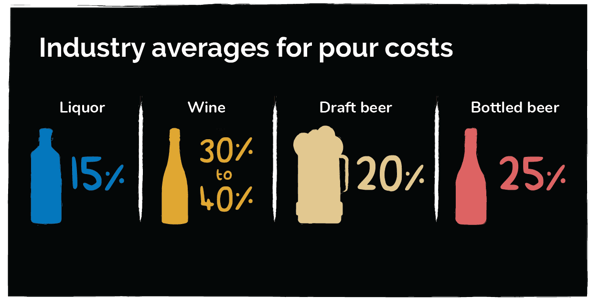Who knew running a successful bar and restaurant would require so much math?
It's unfortunate, but true. Especially when it comes to analyzing costs and profits from liquor sales. Liquor, wine, and beer sales should generate big profits for your business. That's why knowing your pour costs and how to manage them is important.
But once you calculate your liquor costs, how do you know if that pour cost percentage is good? One way to measure it is to compare your numbers to the average liquor costs for bars and restaurants across the industry.
A Short Note about Industry Averages for Liquor Costs
It's good to track and know important performance metrics like liquor costs to make sure your business on the track for success. If your costs are way higher than the average, then the panic alarm should start ringing in your head.
But the average pour costs should only be used as a guideline. A lot of different factors affect costs.
For example, the type of restaurant you run will have an effect. If your venue sells a lot of wine and provides intimate service, your cost of goods will be higher than a nightclub that relies on low-cost mixed drinks sold at high volume.
So it's important to remember that the average might not work for you. You should look at each category of your bar program, like wine, beer, spirits, and cocktails, to know what liquor costs are for each alcohol type sold.
What's a good liquor cost for bars and restaurants
A good liquor cost is between 18 - 24%. That's the average liquor cost across all drink categories. Industry cost benchmarks differ by drink type. So it's important to look at your cost of goods sold by individual drink categories to see your pour costs for wine, beer and spirits. This will help you understand what areas of your bar program perform well and what needs improvement.
Average Pour Cost for Liquor
For spirits, the average liquor cost is 15%. This puts it at the lower end of costs and higher end for profits.
For a bar program, a heavy focus on mixed drinks, bottle service and inexpensive cocktails can generate high profits.
Craft cocktail programs will generate higher pour costs due to the complexity of their drinks as well as higher costs associated for premium spirits. Considering the labor involved is also important, because this will put a cap on the number of drinks that can be made and sold per day.
Average Pour Cost For Wine
For wine, the average cost is between 30%-40%. This puts it at the higher end in terms of individual cost, but bottle sales are great way to drive total sales and increase check averages.
One great way to reduce wine costs is to have a prominent wine by-the-glass menu. With aggressive mark ups, a single glass pour can pay for the full cost of the bottle, allowing some bars and restaurants to make up to 4x profit on a glass pour.
In terms of price markups on bottles, it's important to check your state liquor laws to know how high of a markup can be added to wine. Some states restrict the percentage markup that can be added onto a bottle of wine for restaurants.
Average Draft Beer Pour Cost
Like spirits, draft beer is a cost effective way to serve your guests. Draft beers average pour cost is 20%. Putting it towards the low range of pour cost.
A draft beer program is also a great way to add flexibility to your beverage program, offering a rotating draft selection will give customers new beers to try consistently and can help build repeat business.
Average Pour Cost for Bottled Beer
Bottled beer clocks in at a slightly higher cost than draft beer. Bottled beer averages a pour cost of 25%.




